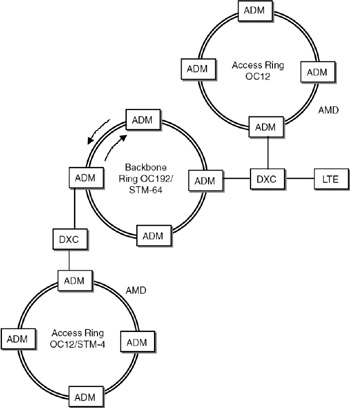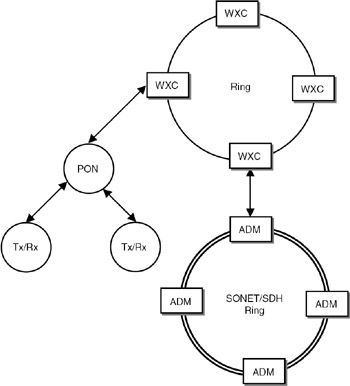14.2 OPTICAL NETWORKS
|
| < Day Day Up > |
|
14.2 OPTICAL NETWORKS
So far, we have discussed optical communication systems for point-to-point links. These systems are transmission systems that can carry optical signals at very high data rates over very large distances. As the optical communication technology matured, a number of proprietary networking solutions were developed. Subsequently, standardization activities resulted in a number of international standards to develop optical networks.
14.2.1 SONET/SDH
SONET (synchronous optical network) is a standard developed by American National Standards Institute (ANSI) for optical networking in North America. International Telecommunications Union Telecommunications Sector (ITU-T) developed a slightly different standard that is called synchronous digital hierarchy (SDH). SONET/SDH standards specify how to access single-mode optical fiber using standard interfaces and how to multiplex the digital signals using synchronous TDM. These standards specify the rate hierarchy and interfaces for data rates from 51.84Mbps to 39.813Gbps.
Synchronous optical network (SONET) is a standard for optical networking. SONET was developed by ANSI for North America. A slightly different standard used in Europe is called the synchronous digital hierarchy (SDH).
The signal hierarchy in SONET/SDH is shown in Table 14.2.
| Optical Carrier (OC) Level (STM) Level | SDH Synchronous Transfer Model | Data Rate | No. of 64kbps Channels |
|---|---|---|---|
| OC-1 | 51.84Mbps | 672 | |
| OC-2 | 103.68Mbps | 1,344 | |
| OC-3 | STM-1 | 155.52Mbps | 2,016 |
| OC-4 | STM-3 | 207.36Mbps | 2,688 |
| OC-9 | STM-3 | 466.56Mbps | 6,048 |
| OC-12 | STM-4 | 622.08Mbps | 8,064 |
| OC-18 | STM-6 | 933.12Mbps | 12,096 |
| OC-24 | STM-8 | 1.24416Gbps | 16,128 |
| OC-36 | STM-12 | 1.86624Gbps | 24,192 |
| OC-48 | STM-16 | 2.48832Gbps | 32,256 |
| OC-96 | STM-32 | 4.976Gbps | 64,512 |
| OC-192 | STM-64 | 9.953Gbps | 129,024 |
| OC-768 | STM-256 | 39.813Gbps | 516,096 |
A typical network based on SONET/SDH standards is shown in Figure 14.5. Though the network can operate in any topology such as star or mesh, dual-ring topology is the preferred choice. In dual-ring topology, there will be two fibers. One fiber will transmit in one direction and the other fiber in the opposite direction. The advantage of this topology is that even if one link fails, the communication does not fail. Such a topology leads to survivable networks—networks that can survive even if some links fail. As shown in the figure, there can be a backbone ring that operates say at OC-192/STM-64. The backbone network may interconnect major cities in a country. In each city, there can be a ring operating at different speeds from OC-3 to OC-12. The add-drop multiplexer (ADM) is used to insert the traffic channels into the SONET/SDH transmission pipe as well as to take out traffic channels from the pipe. DXCs (digital cross connects) connect two rings and also do the multiplexing/demultiplexing and switching functions. The line terminating equipment (LTE) provides user access to the network.

Figure 14.5: SONET/SDH network.
A SONET/SDH network operates in dual-ring topology. One fiber is used for transmitting in one direction and the other fiber for transmission in the opposite direction. This topology facilitates development of survivable networks—the network can survive even if one link fails.
The ADM and the DXC are the two important network elements that provide the networking capability. The functioning of ADM and DXC can be understood through the analogy of a train. When a train stops at a railway station, some people get off and some people get on; the traffic is dropped and added. ADM does a similar function. The traffic for a particular place (in the form of TDM slots) can get dropped and added. The input to the ADM can be an E1 link with 30 voice channels. Some channels, say 10 voice channels, meant for a particular station can be dropped and another 10 voice channels can be added.
Continuing with our train analogy, a train may stop at a railway junction, and some coaches can be detached and some coaches can be attached to it. The detached coaches are connected to another train. The attached coaches would have come from some other train of a different route. The DXC performs a similar function. Traffic from different stations is multiplexed and demultiplexed, and also switching is done at a DXC.
The add-drop multiplexer (ADM) and the digital cross connect (DXC) are the two important network elements in an optical fiber network.
14.2.2 Optical Transport Networks
Similar to a SONET/SDH network, a WDM network can be developed as shown in Figure 14.6. A WDM ring can act as a backbone network. The backbone ring can be connected to a SONET/SDH ring or to passive optical network (PON). The network elements in the WDM network will be OADM (optical ADM) and WXC (WDM cross connect), which do similar functions as ADM and DXC, but in the optical wavelengths. At each WXC, a SONET/SDH ring can be connected that serves different cities. Compared to the SONET/SDH network, this network offers much better capacity and flexibility. The PON can be any of the present optical networks based on star or ring topology.
An optical transport network consists of a backbone WDM ring to which SONET/SDH ring or passive optical network (PON) can be connected. The network elements in this configuration are optical ADM and WDM cross connect.
The network shown in Figure 14.6 has one problem that needs to be addressed. The data needs to be converted from electrical domain to optical domain as well as from optical domain to electrical domain. This calls for additional hardware. To avoid these conversions, all-optical networks are being developed. Research in this direction is very promising, and commercial products are in the works.

Figure 14.6: WDM network.
|
| < Day Day Up > |
|
EAN: 2147483647
Pages: 313